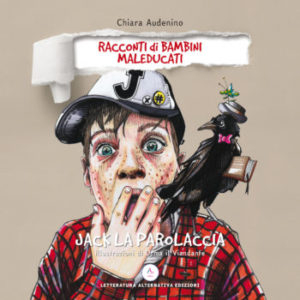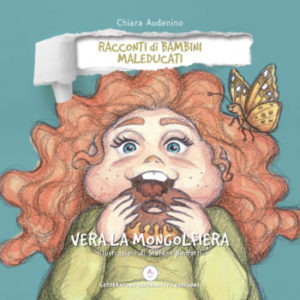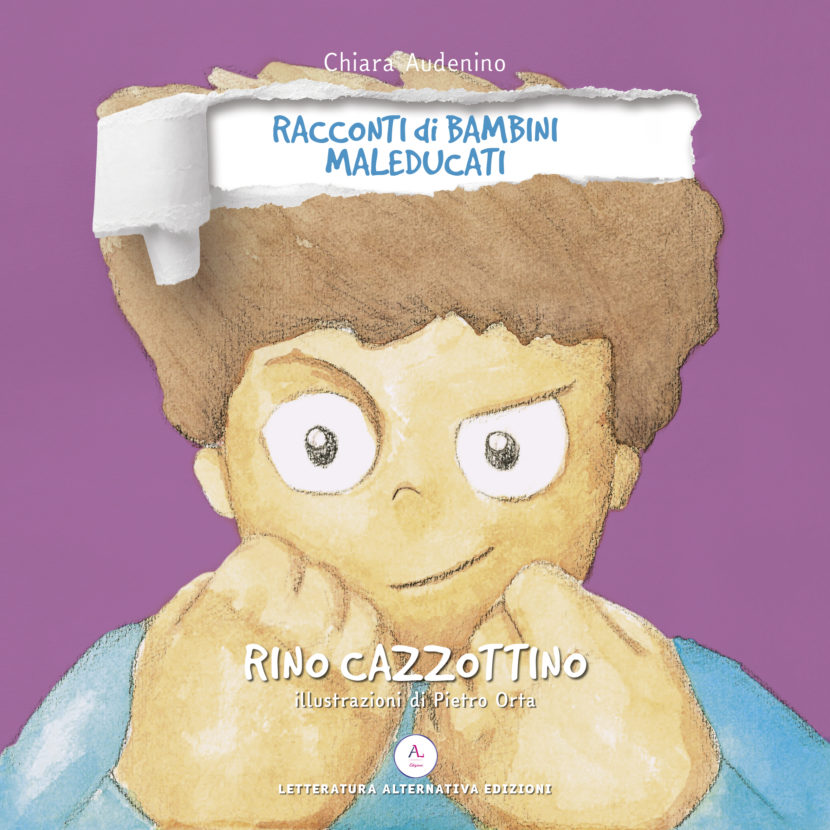Chiara Audenino has discovered that writing is her passion. Born on January 1st, 1973, Chiara has been working as an employment advisor in Turin for over 20 years. She uses irony and grace to convey emotions while drawing upon the constant dialogue with her children as her inspiration. They see life through the lens of their young age while expressing, in their own terms, personal standpoints. Her dream, one that has finally been accomplished, was to publish a story for children that can be shared around the world and remembered in time. Racconti di bambini maleducati (Tales of Rude Children) is the title of her first series of children’s novels published by Letteratura Alternativa Edizioni , a young and dynamic publishing company founded by Romina Tondo in Asti. Following the publication of Jack La Parolaccia (Jack the Swearer) and Vera la Mongolfiera (Vera the Fatty), Chiara returns with her third book, Rino Cazzottino (Rino the Puncher). She chose to use the inclusive EasyReading font for all of her books.

What type of training did you need to write Tales of Rude Children?
“I’m an employment advisor and mother of three children with a passion for writing. I’m therefore neither a psychologist nor teacher; simply put, I’m a careful observer. I studied languages and literature, but emotion was the main ingredient I used to write these stories. I decided to address primary school children because middle school is already too late! During the five years of primary school, children are like clay—they can be easily moulded. After that, it becomes more difficult. They already have their traits and if these are inappropriate, then it won’t work.”
How did your role as an employment advisor influence your writing?
“An employment advisor implements current legislation, enforces the rules and aims to recommend the right course of action. This quest for thoroughness, combined with the need to find the right solutions—inherent in my role as a professional—is partly reflected in these tales. But there’s much more than that, including my motherly nature—which teaches children to respect their fellow human beings. Understanding the motivations that lead to specific behaviours that are inappropriate, taking the side of the weakest ones and not the bullies to curb those children who behave badly: this is the role of the mother that emerges in my stories.
We are used to dealing with certain issues starting from the victim and not the persecutor. Why this choice?
“In Tales of Rude Children, I give voice both to the victims and the bullies. Their thought process is often different from what one would expect and from what they portray to others. Behind a bully there is always discomfort and that’s exactly what needs to be addressed. The role of the victim must be combined with that of the person who observes the repeated abuse. This is the profound difference that must take place at the social level. The behaviour of spectators who notice the wrong behaviours of the bullies is key to changing the bully’s attitude or to strengthen his or her reprehensible behaviour. And that’s why children must know which side is right and recognise who is misbehaving.”
What inspires you most?
“I was encouraged to write these tales by everything that I read in the newspapers and by the stories that my children tell me when they come home from school. There are many more cases of children with ill manners than ever before. While observing certain changes, I told myself: something must be done to help these children to change before they grow up and become abusive adults (this is my biggest fear). What must be taught, other than school subjects, is how to put oneself in the shoes of others and become empathetic adults.”
Have you ever been bullied in turn?
“During fifth and sixth grade, I was a tomboy and loved to eat. I was quite plump, a little like the character in Vera the Fatty. At school they called me “Bowler Hat Jo” (“bowler hat” because I was fat and “Jo” because I was a tomboy). Just like Vera, I let them talk and suffered in silence, but I smiled because I didn’t want to give in. It was harder for me to give up a succulent dish of pasta because I was always hungry. Then I combined healthy sports with my lifestyle and became a tall and slender girl. When I passed from being a caterpillar to a butterfly, the bullies who used to make fun of me now buzzed around me like flies, this time to woo me. They had no chance since my friends were those who loved me and thought I was beautiful even with a few extra pounds.”

Your books apparently target all children: bullies, their victims, parents and those who have reading difficulties. A rare educational model.
“I really hope that these books can be used as a reflection and that my project becomes an education model. If children behave badly, this means they have wrong reference models or they don’t learn the right rules and receive proper teachings. An adult lies behind every child’s ill manners, or the lack of education received from an adult. My books should be read by children together with adults, because the adult needs to understand how to grasp the possible discomfort a child has or to discover that he or she is actually the cause behind the child’s bad behaviour. Even an adult has a duty to change if he or she is wrong. I am the first to say that I am an imperfect mother: when I make a mistake, I correct myself and try to make up for it. This project is also linked to inclusion and I did not want to leave anyone out. For this reason, I included children who have some additional difficulties with reading. My youngest son is dyslexic and the oldest one is a border-line dyslexic, so I know that a font can truly make a difference. A dyslexic child doesn’t like to read because he or she really struggles. A highly legible font helps a lot and invites the reader to continue.”
In your experience, can a learning disorder such as dyslexia cause aggression, leading in turn to bullying?
“When a learning disorder such as dyslexia is not acknowledged, it can cause a child to lose self-esteem, make him or her more nervous and irritable, and, above all, make him or her unwilling to study. In some cases, it can also lead to stress-related health problems. Recognising this type of issue and finding the right strategies to overcome these difficulties are essential steps to raise a peaceful child. For me, bullying is something else: it is linked to incorrect teachings, values that have not been transmitted and a lack of sensitivity. I’ve always wondered, what would happen if a bully put himself in the shoes of a victim, would he or she continue to be a bully? I don’t think so. That’s why we must always teach children to put themselves in the shoes of others.
What kind of feedback do you receive from your readers? From schools? From parents? From children?
“I actually didn’t know if these books would catch the attention of children and adults. I used a unique style, one that shows the same scene from the point of view of the different characters and explicitly portrays their thought processes. I adopted a language that was not strictly targeted to children because I believe that a children’s book should enrich the child’s vocabulary. I introduced final notes that reveal what happens afterwards to the various characters of the story (I discovered that children really like these notes!). Nevertheless, I needed to test these books in schools, having teachers read them. And so it was. Some teachers fell in love with my project and with the books. They finally decided to support them. In some schools, the teachers themselves read the stories to the children. I visited them in class after they had used the books as learning material. They welcomed me as if I were a star and the best question they asked me was: “When’s the next book coming out?”. I got excited because I realised that I had won them over. I then started conducting reading workshops in some schools in Turin for children in third, fourth and fifth grade. Conducting workshops in schools located in the outskirts, where the classes are mixed—with children from families with difficult social situations—was a truly enriching experience. Their reactions made me think that what I was doing was correct: if I had managed to conquer even the so-called “difficult children”, then this was the right course of action. The teachers afterwards provided me feedback from the enthusiastic and curious children. The children handed me their drawings of the books and their reviews. My goal is that Tales of Rude Children be adopted as a tool in schools and families to prevent misbehaviours. Some parents thanked me for talking about the problem of chubby children being made fun of, while others told me that they are glad we finally opened up about the swearing problem because, after all, everyone gives their opinion and complains, but no one does anything to avoid it.”
What is the relationship between your readers and dyslexia?
“More and more children have problems with dyslexia. Everything would be easier if schools used books with highly legible fonts for all children so to avoid making distinctions, i.e. you are dyslexic, and you are not! Learning methods for dyslexic children simplify life for everyone, not just dyslexic children, so why not use them across the board? I’m not a teacher, but if I were, I’d strive for that in all schools. My goal is to encourage dyslexics to read and not make them feel different from others.
How many of your readers are dyslexics?
“A lot of them—and many grandparents, parents and teachers thank me for thinking about them. A font like EasyReading can make a real difference.
Who’s the illustrator of your books?
“I needed a visionary to put a face to a swear word and a dictionary. Emanuele Mannisi, aka Orma the wanderer, fully succeeded with his style to render beautiful drawings of Jack. For Vera the Fatty, I needed a soft sketch of a somewhat nostalgic illustrator, and Stefano Bonfatti was the right choice for me. Stefano is a portrait painter who invented the technique of drawing his portraits on wood with a blowtorch; he is not a book illustrator either. After commissioning a painting for our wedding witness, I understood that I wanted Vera to be drawn by him. For Rino the Puncher, instead, I played a home match, taking advantage of the oldest son of my cousin Ilaria, who’s like a sister to me. Pietro Orta—I consider him my nephew even if he is not—is sixteen years old and a truly gifted as a painter, ever since he was a child. When he accepted the challenge of drawing Rino, I was extremely happy because I saw him born and I’m happy if he can start learning with me and maybe one day become a renowned illustrator. I will also entrust him illustrating the fourth book, Stella, Clemente e la sedia magica (Stella, Clemente and the Magic Chair) because he wants to experiment with a new technique. We will see about the others.”
How do you choose the subjects of the illustrations?
“Subjects are created by illustrators based on their imagination. Except for the first book, where everything was new to me, for all the others I decided to give the illustrator a storyboard of the scenes I wanted to be drawn, so to make the tasks easier and speed up the process. They then do the rest.”
How did your interest in EasyReading come about? From an unforeseen need related to a family member or from an interest strictly related to learning?
“My interest started out precisely from my children and because I wanted my educational project to include everyone, even those children who have difficulty distinguishing between letters. For them, reading should be a pleasure and not a nightmare. I can’t stand to live without reading new books. When I tell that to my dyslexic youngest child, he almost takes me for mad. In order to avoid him getting discouraged, I often read aloud for him. I do this to make him understand how many stories are contained in a book and that you should never give up when you are faced with fonts that you do not understand. Books are almost always worth reading.”
What is your latest book Rino the Puncher about?
Ever since he was a little kid, Rino has an annoying itch in his hands that makes him throw punches and slaps anyone who happens to be in range. Rino’s own hands will find the solution to eliminate the “PUNCHING ITCH” by turning to the fabulous Tree of Remedies. This story is about being aggressive and what causes this bad behaviour. It is better to use one’s hand to build things and not throw punches. This is the overall message of the book. The presence of magical elements plays a very important role in each story and serves to capture the attention of the young reader, otherwise it would turn into a boring read after two pages. Even if the solutions are apparently supernatural, they anyway lead the child to think that there is a possibility to change their behaviour.”

Do you already have other characters in mind for the next books you will publish? Will you still use EasyReading?
“I have a publishing contract for nine books with the publishing company Letteratura Alternativa Edizioni: the fourth story will be published by Christmas and will focus on disability and foster care. I will then publish a book that will deal with the problem of teasing and name-calling, one on the lack of kind manners, one on an Egyptian child who is made fun because of the colour of his skin, and another will focus on the bad behaviour of girls and will be linked to online bullying. Finally, I will publish a book where a grandfather is the main character: he will watch, downhearted, at how rude his grandchildren are and compare this (with the pros and cons) to the strictness of his time.
Will I use EasyReading? Of course! Since I’m superstitious, before any of my books gets published, I always call Mr. Federico Alfonsetti and have a chat, because human relationships are always central to any choice I make. I found out that the creator of this font is a kind and extremely helpful person. I can’t help but support the use of this font, I’m now a fan of it too.”

